<em>Modern Drummer</em> Education Team Weighs In On: Favorite Drum Books

(Updated 12/10/15)
We asked the members of the MD Education Team to give us their five or so favorite drum books. Here’s what they said.
Joe Bergamini
I use dozens of books in my teaching practice, and I have written and edited many books as well. Here are probably my favorite and most-used drum books:
1. Alfred Drum Method 1 by Dave Black and Sandy Feldstein: This snare drum method still seems to me to be the most logical step-by-step approach to teach a new drummer how to read music, play basic rhythms, and learn rudiments.
2. Stick Control by George Lawrence Stone: What can I say that hasn’t been said before? This is the Bible of developing good hands.
3. Realistic Rock by Carmine Appice. It really delivers what the title says. If you can play everything in this book, you will be able to play most classic rock songs, and that’s what many of my students want to do! Keep in mind that you shouldn’t just play through the book as written; you can and should vary the ride and left-foot patterns as Carmine recommends. Advertisement
4. Future Sounds by David Garibaldi. This is my favorite drum book. When practiced correctly, it simultaneously improves your time and groove, coordination, musicality (due to the “two sound level concept”), creativity, and rhythmic vocabulary (including some very cool odd phrases). To say nothing of the fact that everything between its covers is insanely funky.
5. The Art of Bop Drumming by John Riley: The best all-around book in existence to begin to understand and play jazz on drums.
6. Afro-Cuban Rhythms for Drumset by Frank Malabe and Bob Weiner: Any intermediate to advanced student I have ever taught is nodding their head right now. Even if you don’t think you’ll ever play a Latin gig, you must go through this book if you are a serious player.
7. Advanced Techniques for the Modern Drummer by Jim Chapin: This remains a benchmark for coordination and independence.
8. Groove Essentials 1.0 by Tommy Igoe: If you can nail every song in this book, you can play a pro gig. Enough said.
9. Master Studies by Joe Morello: The pro drummer’s handbook to developing and maintaining facility and technique.
10. The Encyclopedia of Double Bass Drumming by Bobby Rondinelli and Michael Lauren: A very musical and effective intro to double bass, and packed with really fun grooves and licks. I favor this book for double bass because you can actually use the material on the right rock gigs. Advertisement
There are many, many other books I use and love. Here are just a few that I use all the time (including the level of player that I feel each book is aimed at):
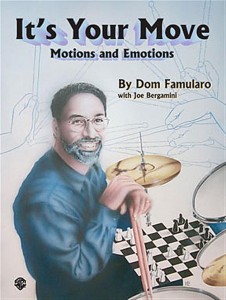
It’s Your Move by Dom Famularo
It’s Your Move by Dom Famularo with Joe Bergamini (intermediate to advanced)
The Commandments of R&B Drumming by Zoro (intermediate to advanced)
Beyond Bop Drumming by John Riley (advanced)
Baby Steps to Giant Steps by Jim Rupp and Peter Retzlaff (beginner to intermediate)
The New Method for Afro-Cuban Drumming by Jimmy Branly (advanced)
Portraits in Rhythm by Anthony J. Cirone (advanced)
Drumset 101 by Dave Black and Steve Houghton (beginner)
Rhythmic Illusions by Gavin Harrsion (advanced)
Advanced Funk Studies by Rick Latham (intermediate)
I’d also like to mention a couple of my own books that my students really enjoy. I’ve written several books that study the greats, and they create a nice supplement to the methods above. With Wizdom Media, my company with Dom Famularo, we’ve also released several titles that really fill in some holes in the available literature.
Neil Peart: Taking Center Stage by Joe Bergamini
Drum Techniques of Led Zeppelin by Joe Bergamini
MD Classic Tracks by Joe Bergamini
Pedal Control by Dom Famularo and Joe Bergamini with Stephane Chamberland
Eighth Note Rock and Beyond by Glenn Ceglia
The Weaker Side by Dom Famularo and Stephane Chamberland
Arrival Drum Play-Along by Joe Bergamini with Dom Famularo
I hope you get a chance to check out some of the titles on my list. There are also many great DVDs to recommend. Maybe we can do a separate article about those!
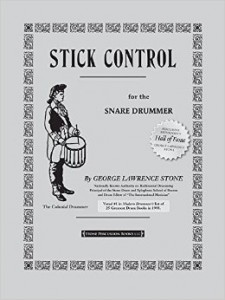
Stick Control by George Lawrence Stone
Steve Fidyk
1. Stick Control
2. Syncopation
3. Master Studies
4. Rudimental Swing Solos
5. Portraits in Rhythm
6. Advanced Techniques for the Modern Drummer
7. The New Breed
Jeff Salem
1. Modern Reading Text by Louie Bellson
2. The Art of Bop Drumming by John Riley
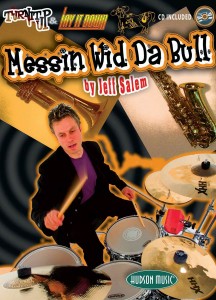
Messin Wid Da Bull by Jeff Salem
3. Groove Essentials by Tommy Igoe (book and DVD)
4. Messin Wid Da Bull by Jeff Salem
5. Future Sounds by David Garibaldi
6. Live BPM (beat detector app)
7. The Latin Rudiments by Chuck Silverman
8. It’s Your Move by Dom Famularo
9. America’s N.A.R.D. Drum Solos
10. Secret Weapons for the Modern Drummer by Jojo Mayer
Mike Sorrentino
First and foremost, I suggest that every student put on music and play along for hours. It amazes me that I actually have to tell them to do that nowadays! Then, when it’s time to geek out on practice material, here are my favorites.
1. Elementary Drum Method by Roy Burns
2. Syncopation by Ted Reed
3. Stick Control by George Lawrence Stone
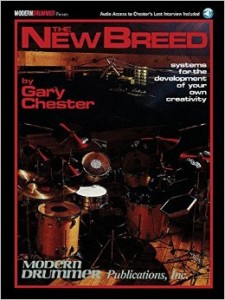
The New Breed by Gary Chester
4. Time Functioning Patterns by Gary Chaffee
5. America’s N.A.R.D. Drum Solos
6. The New Breed by Gary Chester
7. Baby Steps to Giant Steps by Pete Retzlaff and Jim Rupp
8. Advanced Techniques for the Modern Drummer by Jim Chapin
9. Secret Weapons of the Modern Drummer by Jojo Mayer
10. Double Bass Drumming by Joe Franco or The Encyclopedia of Double Bass Drumming by Bobby Rondinelli and Michael Lauren
Jason Gianni
1. Progressive Steps to Syncopation for the Modern Drummer by Ted Reed
Simply referred to as Syncopation by the majority of drummers, this historic book has been around for over half of a century and is perhaps the most utilized drumset exercise book in drumming pedagogy today. The book, for the most part, contains simple steps to building and understanding rhythmic reading, especially in the first thirty-plus pages. However, the eight pages of forty-bar exercises of mixed rhythms that have an unlimited amount of applications to the drumset are the most popular. As with all these books, it’s important to align yourself with a good teacher to really show you how to use this book in a multitude of ways. Advertisement
2. The New Breed by Gary Chester
Chester popularized the concept of using groove-oriented systems (or ostinatos) with this book, and contemporary drummers have taken these ideas to extreme levels.
3. Stick Control by George Lawrence Stone
Stone’s book is the holy grail of hand development. As with the previous two, there are many combinations and applications of the exercises that can be used to develop not only hand technique, but also foot chops, limb independence, and endurance. Again, a good teacher will open your mind to the endless possibilities contained throughout this book.
4. The Art of Bop Drumming by John Riley
This is a must-have for drummers who want to have a strong background in jazz concepts. The book contains everything from exercises for soloing and independence to historic text mentioning the most influential jazz drummers. John Riley is one of the most reputable educators, players, and historians in the world, and this book is a great summary of his wealth of knowledge.
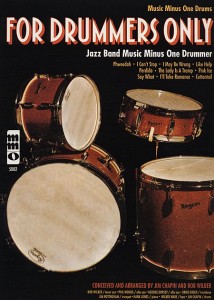
For Drummers Only by Jim Chapin
5. For Drummers Only by Jim Chapin
This book was assembled in the late-’60s by Jim Chapin and is one of the most usable resources for big-band chart reading available. Unlike a lot of current play-along recordings that have the drums removed digitally, these recordings were made in a live setting with a real big band with Chapin keeping time on the hi-hat. The charts can be a little confusing at times, but the notes/figures themselves are accurate and are very helpful for drummers interested in working with a big band. Advertisement
6. A Funky Primer by Charles Dowd
This is one of the most usable books on standard rock patterns. The layout is easy to follow, as you can compare the patterns above and below each other to see the variations from groove to groove. There are an endless amount of applications that can be used with these grooves (converting them to odd-time meters, adding polyrhythmic accents, adding more ostinatos, etc.). There are not necessarily any groundbreaking theories here, but the book contains a great collection of usable patterns in any rock or groove-related circumstance.
7. Future Sounds by David Garibaldi
When coupled with Garibaldi’s compilation of classic Tower of Power drum transcriptions from his other book, The Funky Beat, you have perhaps the best assortment of funk drumming education available. Future Sounds delves into Garibaldi’s methods of how he creates drum parts and offers endless possibilities for pattern development.
8. The Drummer’s Bible by Mick Berry and Jason Gianni
The Drummers Bible has been a labor of love for Mick and me. It’s over 200 pages of every drum style we could think of for the current working drummer. It consists of primary patterns followed by a few practical variations. Part historic and part instructional, there’s a lot of information included, as well as two CDs with demonstrations of nearly 200 grooves. Advertisement
David Stanoch
As an educator and student myself, I’m a fan of all resources available to inspire, improve, and enjoy the journey, be it magazines, books, DVDs, the Internet, recordings, or performances. We are fortunate to live in an era where there is so much information available to us.
I found it difficult to narrow down my essential resources to only five or ten choices, so I’m taking the liberty of listing ten categories of choices based on the subject matter they represent.
Let’s Rock!
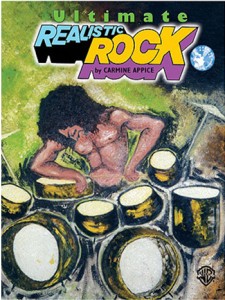
Realistic Rock by Carmine Appice
Realistic Rock by Carmine Appice and Song Charting Made Easy by Jim Riley
Many of my students come to me with a background in rock drumming. I’m still a fan of Carmine’s classic book because it’s easy to digest and the exercises are legit for the genre. It helps smooth out rough edges the student might be experiencing in executing a “big beat.”
Jim’s book is much newer but essential because it gets the student recognizing the bigger picture of basic chord structure, harmonic movement, and form in a user-friendly fashion via play-along tracks. It also teaches a practical method for producing a shorthand chart. Advertisement
Back to the Roots
The Essence of Afro-Cuban Percussion and Drumset and The Essence of Brazilian Percussion and Drumset by Ed Uribe and African Rhythms and Independence for Drumset by Mokhtar Samba and Dan Thress
The Uribe books are like nothing I’ve ever seen. There’s history, rhythm section scores, hand percussion patterns, and plenty of drumset study, and both books have CDs that are essential for absorbing the feel of the music. Samba and Thress’ book/CD is a fabulous introduction to modern African drumming and culture.
Bring on the Funk
The History of R&B/Funk Drumming by Yogi Horton and Commandments of R&B Drumming by Zoro and Russ Miller
The video of Yogi is one of the first instructional tapes ever produced. It has been out-of-print for years but is available online and is worth watching over and over. Yogi’s playing and insights were a tremendous gift that’s thankfully preserved for all of us to enjoy. Advertisement
There are a lot of great method books on funk drumming, notably those by David Garibaldi and Jim Payne, but this book by Miller and Zoro lays out the history of the genre with great detail.
Swing Is the Thing
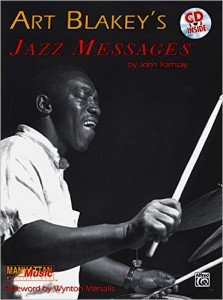
Art Blakey’s Jazz Messages by John Ramsay
Art Blakey’s Jazz Messages by John Ramsay and Brush Artistry by Philly Joe Jones (with video demonstration by Mel Brown available online)
There are many terrific resources on jazz, but what I love about Ramsay’s book is how he captures the nuances of Blakey, who’s a true pioneer on the instrument. Although long out-of-print, Philly Joe’s method book on brushwork is a classic.
One Step Beyond
Life on Drums by Billy Martin and Allen Herman
Through engaging conversation and performances, Martin and Herman shed light on how to develop a strong foundation as a drummer and how to think outside the box as an accompanist and soloist.
The Space Between Beats
Time Awareness for All Musicians by Peter Erskine and Mastering the Tables of Time by David Stanoch
Of all of the prolific contributions the great Peter Erskine has made, in my opinion, this is his masterpiece. It’s a must-have for any serious player, but even if you’re not serious read it anyway. You’ll be glad you did. Advertisement
Having been inspired by Tony Williams and Joe Morello to develop exercises based on the table of time to improve my inner clock, imagination, phrasing, control, and technique, I decided to write my own book. A solid groove, a good feel, and steady time all begin with a strong sense of subdivision. The book works to create confidence in establishing that foundation.
Get on the Good Foot
Secret Weapons for the Modern Drummer, Part 2: A Guide to Foot Technique by Jojo Mayer
While there have been some fine works on bass drum control in the past, there’s no precedent for the amount of content this DVD teaches us on the subject.
It’s Groove Time!
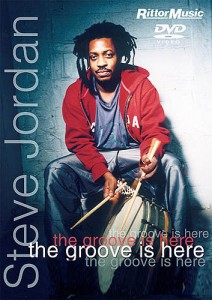
The Groove is Here by Steve Jordan
The Groove is Here by Steve Jordan, Jeff Porcaro: Instructional DVD for Drums, Steve Gadd’s Up Close, and Billy Ward’s Big Time
These four DVDs are priceless if you’re looking for information and inspiration to improve your groove. In Steve Jordan and Jeff Porcaro’s works, you’ll see focused approaches on how to lay down a strong foundation. The playing in each DVD is absolutely stellar. Advertisement
Gadd’s DVD demonstrates how thoughtful and deep of an artist he truly is. His words contain endless pearls of wisdom, and you can tell from anything he plays, from snare solos to forward-thinking beats, just how important every note is.
Billy Ward’s DVD introduces us to his free-spirited character and creative approach. Billy has fresh, clear concepts and some off-the-wall ideas that help open the door to how to develop a very personal approach to the instrument.
This Is How You Do It
Drum Wisdom by Bob Moses and Pocket Change by Ndugu Chancler
Although these books contain musical examples, the gist of each shares a more philosophic approach to drumming. Ndugu’s book takes you from the foundation to professionalism. Invaluable insights abound in both books. Advertisement
Ancient to the Future
The Drummer’s Complete Vocabulary as Taught by Alan Dawson by John Ramsay, Stick Control by George Lawrence Stone, Syncopation for the Modern Drummer by Ted Reed, and 4-Way Coordination by Marvin Dahlgren and Elliot Fine)
Dawson, who helped found the drum department at Berklee College of Music in 1957, emphasized total musicality as a drummer. Common texts he employed in his methodology include three of the most classic volumes of our instrument.
Stone’s Stick Control is the most classic work of its kind. Dawson would interpret the stickings from it in a variety of ways on drumset and would encourage students to sing melodies while the playing different combinations. Advertisement
Reed’s Syncopation is also the classic work of its kind, and Dawson would interpret the pages in a variety of ways to develop coordination.
Also a fan of 4-Way Coordination, Dawson used this book with his students to help them begin to use the hi-hat foot as an independent voice.
Dawson’s pedagogy has been wonderfully preserved for prosperity and clearly explained in the book by John Ramsay, who was a student and friend of Alan’s. The Complete Vocabulary also includes the famous “rudimental ritual” warm-up for drumset.
Jeremy Hummel
These are listed in no particular order:
Alfred Drum Method, Book 1 by Dave Black and Sandy Feldstein
Groove Essentials 1.0 by Tommy Igoe

Groove Essentials 2.0 by Tommy Igoe
Groove Essentials 2.0 by Tommy Igoe
Great Hands for a Lifetime by Tommy Igoe
Realistic Rock by Carmine Appice
Master Studies by Joe Morello
Beyond Bop Drumming by John Riley
The Art of Bop Drumming by John Riley
The Language of Drumming by Benny Greb
I also use sections of the following:
Essential Drum Fills by Peter Erskine
It’s Your Move by Dom Famularo
The Master Drummer by John Riley
Stick Technique by Bill Bachman
Marko Djordjevic
There are many books containing useful information that pertains to the art of drumming. Out of the books I know about, the following stand out:
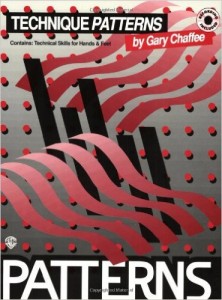
Gary Chaffee’s Patterns
Gary Chaffee’s Patterns series
Gary Chester’s New Breed
Marvin Dahlgren and Elliot Fine’s 4-Way Coordination
Jim Chapin’s Advanced Techniques for the Modern Drummer
George Lawrence Stone’s Stick Control (especially the beginning pages)
All of the above require some musical guidance, as it may be easy to get hung up on playing the right notes without realizing that drumming is made up of a lot more than just playing what’s on the page. Feel, dynamics (both internal and general), flow, touch, sound, and so on, have to be considered in order to say that you’re playing the written material in a musical and relevant manner. The idea is that anything you play, from the simplest beat to the most difficult exercise, ultimately has to sound like music. Miss that, and you might be doing more harm than good.
The drum book I consider the most valuable is Bob Moses’ Drum Wisdom. Way more than a book of exercises, this text is a guide for playing the drums in a musical way. I recommend it to non-drummers as well, as the concepts and ideas Moses talks about go way beyond any particular instrument and reach into the realm of pure music making. Advertisement
Though not at a drum method book, the Real Book merits a mention as a source for learning standard jazz songs. It’s important to develop this repertoire so you can validate all the things you practice out of books by putting them into a musical application. Knowing the tunes in this book also creates a common ground between musicians, so you can perform together without any rehearsal.
Jim Payne
Funk Drumming by Jim Payne
Advanced Funk Drumming: A Progressive Approach to Modern Drumset Grooves by Jim Payne
Drums From Day One by Jim Payne
The Great Drummers of R&B, Funk & Soul by Jim Payne
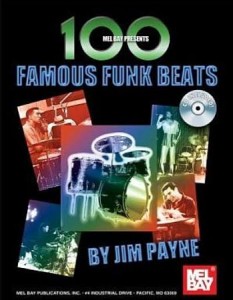
100 Famous Funk Beats by Jim Payne
100 Famous Funk Beats by Jim Payne
Tito Puente: King of Latin Music by Tito Puente and Jim Payne
Modern Reading in 4/4 by Louis Bellson and Gil Breines
The Art of Bop Drumming by John Riley
Groove Essentials 1.0 and 2.0 by Tommy Igoe
4-Way Coordination by Marvin Dahlgren and Elliot Fine
The Funky Beat by David Garibaldi
Funk Drumming: Innovative Grooves & Advanced Concepts by Mike Clark
Jayson Brinkworth
Stick Control
Syncopation
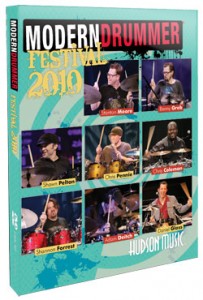
Modern Drummer Festival 2010
Funky Primer
Accents and Rebounds
Future Sounds
Secret Weapons for the Modern Drummer
The Century Project
Modern Drummer Festival 2010
The Language of Drumming
Jeff Porcaro Star Licks
The Groove Is Here
Bill Bachman
I’m of course a little bit biased on this one, but here’s my list of the main resources I use with students. (Keep in mind that I’m usually focusing on hand technique.)
1. www.drumworkout.com
I take drummers of all levels and interests through my Extreme Hands Makeover plan, which is on the site. I also assign different workouts to do, which include play-along videos where students can watch my hands and make theirs match them. Every technical issue you may encounter comes back to some basic fundamental skill that needs further attention, and that’s what this site is designed to do.

Stick Technique: The Essential Guide for the Modern Drummer by Bill Bachman
2. Stick Technique: The Essential Guide for the Modern Drummer by Bill Bachman Advertisement
A portion of this book is culled from my articles in the Strictly Technique section in Modern Drummer magazine, and another portion focuses on my technique opus describing all of the essential techniques thoroughly and simply. This book offers the fast track to well-rounded mechanics that will be used every time you play.
3. The Funky Primer by Charles Dowd
This is a fantastic book for developing independence (coordination) in straight-8th rock/funk. It starts very simple and gradually builds in complexity. By the time you get through the whole book, you’ve worked out a ton of coordination issues, so I don’t think there will be many surprises left.
4. The Art of Bop Drumming by John Riley
These pages are packed with wisdom. Plus, there are independence exercises that include the middle beat of the triplet. Many people learn jazz independence by applying swing 8th-note rhythms from other books, but I feel that you miss so much vocabulary without also exploring the middle beat of the triplet. Advertisement
5. Double Bass Drumming by Joe Franco
I remember looking through this book at the store and thinking it seemed pretty simple. I bought it primarily with the purpose of putting miles on my left foot. The content looks pretty simple on paper, but it took a lot of time to be able to play all of the hand/foot combos accurately and convincingly.
Marc Dicciani
For me, the answer to this simple question is long and complicated because it has to do with how we learn and improve as a result of how our brain, nervous system, and body functions. I’ll be more direct and brief here, but look for a future in-depth article on this topic.
As a result of study and research in areas including neurobiology, neuroscience, psychoacoustics, cerebral physiology, perception, and cognition over the past six years, I believe that using books or instructional products alone is not an effective way to develop into a highly skilled musical drummer. In fact, working from instructional materials incorrectly could actually be counterproductive to this goal, so I’m hesitant to post a list of books and other materials without an explanation. Advertisement
Which books or instructional materials we use to practice is not as important as how we use them. Books tend to be filled with examples, but if we just practice and memorize the examples instead of the underlying principles, our learning is illusory. Sometimes we tend to mistake fluency in playing examples with mastery of the underlying content.
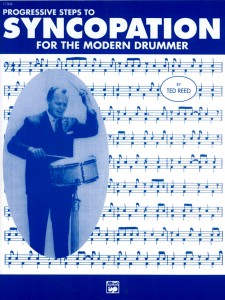
Syncopation by Ted Reed
That said, the top-three books that I recommend for all students are: Syncopation (Ted Reed), Modern Reading Text in 4/4 (Louis Bellson), and Stick Control (G.L. Stone). These books are effective because, when practiced correctly, they allow for your interpretations and ideas of how to use them. Other books that I often use, because they are more open-ended and encourage you to experiment and improvise, include those by John Riley, Rick Latham, David Garibaldi, Gary Chafee, Jason Gianni, and the late Chuck Silverman.
Techniques need to be put into a musical context, which is where playing along to recordings, loops, and drumless tracks become indispensible in our development. Also, work with a qualified instructor who can give you instant objective feedback, record yourself playing, watch drum videos, read books and magazines about music, drumming, and drummers, go to concerts, attend clinics, experiment with different tunings and setups, and jam with other musicians often. All of these things work together to help you grow. Advertisement
There’s no magic, quick fix, or short cut to becoming a great drummer. It requires time, commitment, enthusiasm, and patience, along with humility and respect for the instrument, the techniques, and the music. I tell my students to go where others don’t, dig deep, ask the right questions, never lose sight of your goals, take risks, and be brutally honest with themselves. Good luck, and enjoy the ride!
TO VIEW PREVIOUS EDUCATION TEAM QUESTIONS CLICK HERE.



